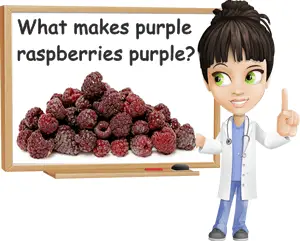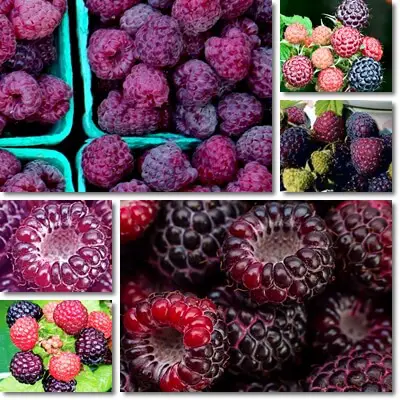What makes purple raspberries purple? Where do purple raspberries get their color exactly? Are purple raspberries GMO? Where do purple raspberries come from? What is the difference between purple and black raspberries? What is the difference between purple and red raspberries? What about purple vs yellow raspberries?
What are purple raspberries?
Purple raspberries are a variety of raspberry with purple fruit instead of red. There are actually several different varieties of purple raspberry differing slightly in color, fruit size, taste and growing habits (e.g. flowering and fruiting season, number of crops per season, hardiness, resistance to disease, adaptability). Color may range from a deep reddish purple to dark purple with bluish tones.

Are purple raspberries GMO?
A lot of times more unusual colors in our food drive the question: is it genetically modified? We’re all used to food looking a certain way and when novel colors pop up we can’t help but wonder if they occurred naturally or are a result of human intervention in the form of genetic engineering.
We’re not used to seeing black or red or yellow carrots instead of the more common orange carrots, or watermelon that is yellow or orange inside instead of red, or tomatoes that are purple or blue or black instead of red. We’re also not very used to seeing raspberries that are purple or yellow instead of red. If a food is common and it looks a certain way for long enough, we tend to get comfortable in the idea that that’s the only way it’s supposed to look naturally.
But nature is amazing as it produces the most diverse of colors all by itself, with no help from us. Just like yellow carrots occurred naturally and came before orange ones, and purple too, so have purple raspberries occurred naturally, and yellow ones too. It’s true that they can be obtained intentionally as well, but they are not GMO as they can occur naturally without human intervention, both in the wild and in cultivation.
Where do purple raspberries come from?
Purple raspberries are a cross between red raspberries and black raspberries. Red and black raspberries hybridize naturally and the resulting plant is a purple raspberry. Purple raspberries occur naturally in the wild and even in cultivation if red and black raspberry shrubs are planted close together.
While it occurs spontaneously and is a natural presence in the wild, the purple raspberry is now produced intentionally as a commercial crop by crossing red and black raspberry plants. You can also get a purple raspberry plant that is more reddish than purple if you cross a red raspberry with a purple raspberry plant.

Why are purple raspberries purple?
What makes purple raspberries purple is a class of natural pigments called anthocyanins. Anthocyanins are pigments that occur naturally in food and are responsible for different colors such as red, black, blue and purple. Anthocyanins also have therapeutic value such as antioxidant, anti-inflammatory, anti-aging and anticancer properties.
Red raspberries also owe their color to the same class of anthocyanin pigments as purple raspberries, the majority of which are found in purple raspberries too.
However, one of the reasons why purple raspberries are darker colored, as in purple instead of red, is they have a greater content of anthocyanin pigments compared to red raspberries.
Not just this, but purple raspberries have more of certain anthocyanin pigments not present in or present in smaller amounts in red raspberries by way of their other parent, the black raspberry.
Pigments that give purple raspberries their color include:
- Cyanidin: also found in red raspberries, red cherries, cranberries, hawthorn berries, red grapes, red apples, red onion and red garlic, purple and red cabbage, but also blueberries and bilberries, acai berries, elderberries, blue and black grapes, black raspberries and black cherries.
- Antirrhinin: also found in black raspberries, acai berries, blackcurrants and figs.
- Pelargonidin: also found in red raspberries, strawberries, blueberries, blackberries, aronia berries (chokeberries) and Amelanchier berries.
- Chrysanthemin: also found in red raspberries, elderberries, blackcurrants, acai berries, purple corn and black rice, thistle flowers and hibiscus.
- Ideain: also found in red and black-blue berries such as cranberries and lingonberries, blueberries, especially European blueberries (bilberries), and red apples.
- Delphinidin: also found in cranberries, pomegranate, blue grapes and blueberries.
- Myrtillin: also found in blueberries, European and American, blackberries, black raspberries, blackcurrants, huckleberries,
- Malvidin: also found blueberries, Amelanchier berries, red, purple, blue and black varieties of grapes and wine.
Color variation in purple raspberries
Purple raspberries are generally grouped together into one big variety based on their color. However, purple raspberries come in many colors which is clear indication that there is more than just one botanical variety.
Technically, any red and black raspberry plant can hybridize naturally and give rise to a purple raspberry. Red and purple raspberries can also cross and create redder varieties of purple raspberries.
The potential for new varieties of the plant is huge. And you can tell there are different types of purple raspberries based on the color variation in the ripe fruit.
Some fruits are a very dark purple (they look more like black raspberries than purple), with either dark blue undertones or a very dark reddish-purple tinge. There are also purple raspberries that are a more easily identifiable purple color, intense nonetheless, and purple raspberries that are more of a wine color as in deep red with purple tones or just a tinge of purple.
Vs purple, red raspberries tend to be a more consistent red color. By comparison, black raspberries can vary slightly in color intensity whereas yellow raspberries come in different shades of yellow.
Purple vs black raspberries
Black raspberries are one of the parent species of purple raspberries and responsible for their dark pigment. Its by way of their darker colored parent species that purple raspberries end up with a more intense color and a more balanced taste, lower in acidity. Both raspberry colors have a richer flavor with more pregnant fruity notes compared to red.
Vs red, both purple and black raspberries are higher in pigmented anthocyanin antioxidants. The boost in anthocyanin content from black raspberries adds to both the flavor profile and the benefits for health of purple raspberries.
Purple vs red raspberries
Red raspberries are the other parent species of purple raspberries and the source of their reddish color tones and astringency. But compared to red, purple raspberries have a more toned down tart taste and are sweeter, with a stronger fruity flavor, which makes them taste more pleasant overall. Purple raspberries have the same range of benefits as red, but are healthier in certain respects due to their higher content of pigmented anthocyanin constituents.
Purple vs yellow (golden) raspberries
In some circles it is believed that yellow raspberries, also called golden raspberries, arose from purple raspberries via a natural mutation that caused the purple raspberries to not develop their pigment.
In any case, the two raspberry varieties owe their color to different natural pigments.
Not just this, but yellow raspberries have no anthocyanin constituents and little to no tartness. Conversely, purple raspberries are high in anthocyanins and a balanced mix of sweet and tart, overall richer in flavor.
Find out why are yellow raspberries yellow.
Are purple raspberries rare?
Purple raspberries are not quite a rare fruit. When it’s purple raspberry season, you can usually find the variety alongside other colors such as red, black and yellow raspberries. Purple raspberries are a growing commercial presence and commonly picked up for cultivation in home gardens.
However, the variety is not as common as other raspberry colors. In fact, right now, purple raspberries are rarer than all other raspberry colors. Their commercial presence, while growing, is not on par with that of red raspberries, and their harvest season is short which causes a limited supply of the fresh berries even when they are in full season.
